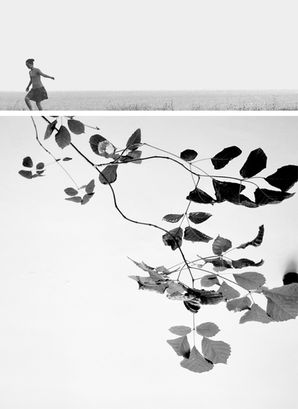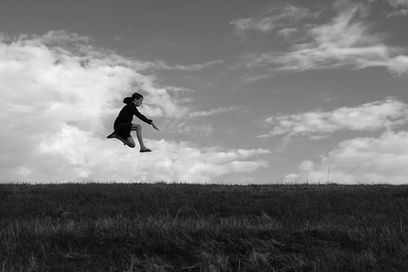
INNER ANCESTRAL TRAVEL
February 1, 2021
INTERVIEW
PHOTOGRAPHY Maurizio Pichi
INTERVIEW Melanie Meggs
Since childhood, Maurizio Pichi has been passionate about photography and has explored many techniques, striving to capture the beauty of small forgotten moments and facial expressions in his images. With his latest project, INNER ANCESTRAL TRAVEL, Maurizio seeks to combine his physical journey through the woods with a journey inward, merging the two into one single narrative. Through his collection of photographs, Maurizio hopes to document the 'archetypes', the original emotions and forms from which all things originate. By taking this journey of exploration and discovery, Maurizio seeks to create a deeply meaningful and powerful photographic series.

“I consider 'Inner Ancestral Travel' as a mature project, intended as an important step in a personal journey. Digging inside and digging into things and situations, I realized that basically there are the "archetypes", the original forms and emotions, from which everything starts. I tried to combine my sensations and the search for forms, merging the physical journey into the woods and the journey within myself, trying to obtain a single narrative through images.”
IN CONVERSATION WITH MAURIZIO PICHI
THE PICTORIAL LIST: Maurizio please tell us about yourself. How did you become interested in photography?
MAURIZIO PICHI: I was born in Arezzo in Tuscany, where I currently live. I owe the “responsibility” of my passion for photography to my grandmother. She was a curious and brilliant woman, she loved to photograph with her Voigtlander 6x6 and later with a 35mm fixed lens camera, a Petri 7sII. When he taught me how to use them, it seemed to me that I was holding something magical in my hand. I always tried to keep a bit of that magic of wonder that you feel when you “see” an image to be captured.
TPL: Talk to us more about you building a large format camera and wanting to explore antique techniques.
MP: This is a project that intrigues me a lot and that is part of the desire to make "portraits" that is growing up more and more. With street photography I have explored and I explore people in action in their environment. With “posed” portraits I would like to be able to “capture” the soul of the subjects and fix it in an image.
TPL: Where do you find your inspiration?
MP: In my opinion, the seed of inspiration is born within us and must be cultivated. When I was teaching photography courses, many times I happened to answer the question of what is useful for taking good photos that can excite. I have always replied that it is necessary to read, visit exhibitions and museums, listen to music and travel. It is necessary to cultivate oneself, to be able to marvel and be sensitive to beauty. This helps a lot in the construction of a narrative thread that can link the images of the same project. Very important is the composition caring, which must be born at the time of shooting. For this reason, an education in vision is very important.
TPL: Do you have a favourite place to photograph?
MP: It depends on the mood. It can be extremely stimulating to go along the course of a river, to be truly guided by the noises of nature, to try to tell those sensations or vice versa to mix with people in places with a lot of movement. Railway stations are an ideal place to gather faces, situations and emotions, in stations you wait, you look. The two situations, natural places and crowded places, have one thing in common: they both have their own music, their own rhythm. We just have to follow him. For example, when I hear the wind and see a flock of birds flying high, I associate it with the sound of a Japanese flute.
TPL: You also do a lot of street photography. What happens when you walk the streets with your camera? Explain your technique?
MP: Street photography is a passion of mine. It's a hunt: situations are sniffed and we try to predict how they will evolve. For this kind of photography you need to be in tune with your equipment to shoot very quickly. As an optic in these situations, I prefer wide-angle lenses that allow me to come into almost physical contact with the subject by shooting at a very short distance.
Live each day as if it were your last. - For me it means not taking anything for granted or achieved definitively. Live, breathe as deeply as possible. Listen and see with all the senses you have. Every day is a new project.

TPL: What do you want to express through your photography? And what are some of the elements you always try to include in your photographs?
MP: I want to show that beauty and harmony can be around us, you just need to open your eyes and soul. I have a series of images which is called "Used". They are photos of abandoned, used objects. With my images I wanted to show that even those who are forgotten or no longer considered useful have their dignity and can have beauty. much depends on how we place ourselves in front of things or people. I can say that in my images there is always an immediately perceptible element. A protagonist. Then, if you look carefully, you can find other elements and points of interest.
TPL: Do you have any favourite artists or photographers you would like to share with us, and the reason for their significance?
MP: Many times I have been told that some of my images, especially nocturnes, recall Edward Hopper, whom I greatly appreciate for his portrayal of repressed and heartbreaking melancholy and loneliness of human beings. I consider his way of seeing very current and contemporary.
Edward Weston is a constant source of inspiration for his religious attention to the plasticity of forms (my photographic avatar, a ball of paper, is unworthily inspired by his Pepper # 30)
I can't help but mention Henri Cartier-Bresson, WeeGee, Gianni Berengo Gardin, Lucio Fontana for his colors, Maurizio Galimberti for his strength as an experimenter.
TPL: Does the equipment you use help you in achieving your vision in your photography? What camera do you use? Do you have a preferred lens/focal length?
MP: Preferring a very dynamic photography, I use the APS-C format. Lightweight and compact equipment. I use my faithful Sony A6000 that I am about to change, with some fixed lenses from 16mm to 60mm, and zoom 16-55mm, 55-200mm. My favorite focal length is 16mm.
TPL: When you go out photographing, do you have a concept in mind of what you want to shoot, or do you let the images just "come to you", or is it both?
MP: I am attracted to both situations. 'Inner Ancestral Travel' is a project that comes from a precise idea around a theme that involves the photographed subjects and post production. So everything is turned in a precise direction from the first moment. The direction in a project must not be felt as a constraint, as a forcing, but as a very strong intent towards the completion of the project which also passes through a selection of images. But I am also attracted to impromptu photography. Being struck by a small detail or by a person's gesture excites me and invites me to take a photo. One thing I complain to myself about is how many photos I've seen and couldn't take because I was driving the car or didn't have a camera with me.
TPL: Are there any special projects you are currently working on that you would like to let everyone know about?What are some of your goals as an artist? Where do you see yourself or hope to see yourself in five years?
MP: I am growing my equipment, in particular lights equipment, because I would like to dedicate myself to portraiture by going to people to have them pose in their environment or even on the street. The commitment will be to bring out a story from a single image. A great challenge. The forbidden dream is to be able to devote oneself to ancient techniques such as wet collodion.
The goal is to be able to keep the fire always lit and the desire to "see" and to show beauty. I do not deny that seeing the emotion of people in front of their images is always an extremely touching and engaging experience. It is as if there is something that unites even if we have never met. Perhaps this is precisely the function of art. So I hope to see myself still walking with my eyes looking for images to collect.
TPL: When I am not out photographing, I (like to)...
MP: I like to read essays on history, particularly medieval. I am interested in the symbols that were used at that time. I love sports, basketball mostly, and movement in general, traveling, hearing music and playing it, even if I'm not very capable.

Maurizio Pichi’s series is a captivating photographic journey that is both physical and metaphysical, allowing viewers to explore the beauty of forgotten moments and discover the emotion and form that shapes our world. With his vision and dedication, he has created something truly unique and meaningful. We invite you to join Maurizio on this journey and explore more of his inspiring work.










































